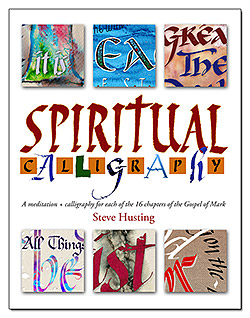These are different kinds of mistakes I’ve seen in myself and others over the years with calligraphy work. Do you see yourself in these areas? In what areas can you work for improvement?
- Jumping right into an important project instead of taking the time to warm up with the lettering and flourishes first, to get into the flow and rhythm, a steady hand.
- To keep on lettering instead of cleaning the pen every few lines. As a result, the strokes are uneven.
- Failure to practice new lettering types with appropriate guidelines and slant lines.
- Forgetting to protect the writing surface from spills, drips, and human oils.
- Failure to clean the nib properly after use. This ruins it sooner rather than later.
- Failure to attune the mind to the work, resulting in mental distractions that introduce errors. Familiarize yourself with what distracts you so you can watch out for it and minimize it.
- When practicing, failure to compare one’s work with the exemplar or ductus critically and regularly, and work on addressing the differences. Don’t mindlessly write letter after letter.
- When practicing a new letter style, failure to practice each letter enough before moving on to the next letter. Getting into words and sentences too early, and never laying the foundation for good lettering fidelity.
- Failure to enforce “seat time,” resulting in getting up too soon before the muscle memory and practice time can really take hold. Work through the roadblock or puzzle. Don’t get up so quickly when it gets hard.
- Never putting in the time and effort to get really good at a lettering type, like Uncial, Italic, etc. Jumping from style to style too soon.
- Believing that “good enough” is acceptable when you are not really trying to reach your full potential. It feels good that others praise you, though you are merely putting in the minimum amount of work.
- In a long project, failure to take regular breaks to stretch and relax.
- Failure to know at what point of the day you do your best work. Is it in the morning? Early evening or later? After yoga?
- Using inferior materials and tools, like crummy nibs, holders, inks, and papers. Or using a fountain pen where a dip pen is called for.
- Working from a poor exemplar or ductus without realizing it.
- Failure to make good use of the resources available, whether meeting with more experienced people, checking out books in the library, or going through exemplars, videos and tutorials online.
- Insisting that your way is the only right way.
- Not taking the time to enjoy your calligraphy; it’s not all about the job or getting it done on time.
- Fearing to continue because you might make an irreparable mistake. So learn how to fix mistakes. Learn to treat each piece as a stepping-stone to something greater. It’s all practice, kid. Perfection is a myth — but striving for excellence is not.
- Not stretching yourself by learning something of the arts that’s new to you, like abstract painting or pencil drawing.
- Endlessly dabbling or practicing, but seldom creating a finished piece.
- Failure to do calligraphy for others to enjoy. When was the last time you did calligraphy to give away?
- Seldom ever learning to use new tools.
- Not learning 2D design principles that could measurably enhance your work and raise it to new heights of professionalism.
- Sticking to artwork of lettering on solid-color paper rather than implementing art elements and borders, lettering embellishments, decorated capitals, or backgrounds into the design.
- Afraid to start a “big” project because you don’t think you’ll be able to finish it. Yet attempting such a project and not finishing it can still stretch your limits.
- It’s OK to do small projects. They don’t all have to take on world-shaking importance. You are not demeaning yourself with smaller projects.
- It’s OK to study and imitate the finished works of others in order to learn from them. It’s not cheating.
- Never creating a 3D work with your skills. Create an accordion book, greeting card, or layered memento.
- Never lending a helping hand to someone who is struggling in their work. Saying negative things that discourage them. It’s not really hard to say, “That’s nice!” or, “You’re off to a good start. Keep practicing!”
- Being too critical of your work. It’s true we want to do better, but we need to accept that we are doing fine with the amount of study and practice we’ve put into it thus far. Continued application of our skills will only improve it. Have patience with yourself and others.
- Failure to familiarize yourself with the differences among inks, nibs, and papers. Some pointed-pen nibs need more pressure to make thick lines; some make finer lines than others. Some inks are too thin and need the drawing surface tilted more to compensate (to offset gravity). Some inks are breathtaking in color and luminosity while others are blah.
- Letting go of the need to keep every single scrap of paper, used or unused, practice pieces or otherwise.
- Being discouraged at your progress, which can often happen when comparing your work with the work of others. Instead of telling yourself, “I’ll never be as good as that,” say, “if I keep practicing, mine can look like that!”
- Sticking to inks and not experimenting with watercolor, gouache, or other media in the nib.
- Feeling rushed to get the work done as quickly as possible. Having no patience for more involved projects.


3 Responses to Typical Calligraphy Pitfalls